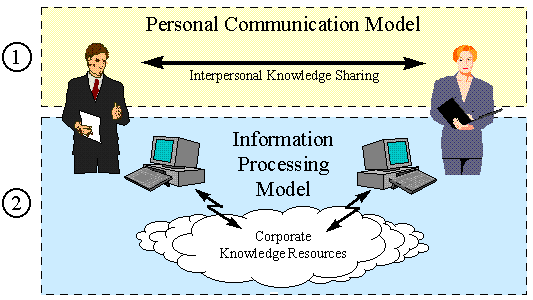 |
 |

Knowledge Management
One of my personal objectives is to provide innovative electronic communication technologies
to help people effectively share knowledge more easily and creatively. My approach
differs from many others involved with knowledge management since I focus on
interpersonal knowledge sharing,
not the electronic capture, storage, transmission, and dissemination of knowledge. I explain
this distinction in greater detail below.
Two Knowledge Management Models
This illustration depicts two different models of how knowledge can be shared between and amongpeople.

D. Verne Morland, NCR Knowledge Sharing Team, © 1997 |
- Personal Communication Model: This model starts with the premise that
knowledge - by definition - resides in the human mind. Extract it and you have only information! Within the mind information can be linked to skill and purpose and such
a linkage or constellation comprises the smallest unit of "knowledge."
From this starting point, it is a straightforward conclusion that the most effective
way to transfer knowledge is by direct, interpersonal knowledge sharing. In
such a context, skill and purpose - the two "ingredients" of knowledge beyond mere
information - can also be communicated. This yields a richer knowledge transfer,
one that is more action-oriented than is possible with the transfer of information alone.
- Information Processing Model: This model is a popular one in the computer
industry. In recent years researchers in other fields have also adopted it.
For example, many psychologists now use the computer as a metaphor for human cognition:
information is acquired through the senses, stored and processed by the brain, and
output through various verbal and non-verbal means of expression. Today, many people
interested in Knowledge Management use this same "capture-store-process-deliver"
metaphor.
To accept this model we must first assume that a knowledgable person's expertise
can be broken down into many individual pieces of knowledge and more specifically,
that these pieces can be independently extracted and stored. (Note: there is evidence
that this assumption diminishes in validity as the breadth of the knowledge domain
increases.)
These two models each have strengths and weaknesses that are illustrated in this
comparison matrix.
Scenario
Consider this scenario. The person on the left has expertise in a certain area (knowledge domain). The person on the right faces a problem in this area but lacks the
expertise to solve it. In this situation, there are a couple of objectives:
- Immediately to transfer the knowledge held by the person on the left
to the person on the right who then solves the problem and
- To make that same knowledge available to other people who may face
the same problem in the future.
Let's see how we could meet these objectives using two different models of knowedge management.
1. The Personal Communication Model
The Personal Communication Model holds that, in general, the person needing theknowledge must
personally communicate with the person possessing the knowledge.During this communication
(which is usually facilitated by communication technologies andneed not be synchronous) the two
people first establish the level at which the necessary knowledge can be exchanged. (In many ways
this can be thought of as avery brief, single incident mentoring relationship in which the mentor
must first determine the vocabulary and complexity that he or she can use when communicating with
the student.)
Once communication is established, the two people discuss the specifics of the problem and potential
solutions. This step can be critically important in that the actual problem may be something
other than the one that the less knowledgeable person has assumed it to be.
Once they are agreed on the problem and the proper course of action for itssolution, the person on
the left provides the person on the right with a numberof specific pointers relevant both to the
case at hand and to the experience of theperson who must actually implement the solution. This
action of shaping theknowledge to the ability of the receiver is one of the strongest aspects
of the Personal Communication Model.
The Personal Communication Model does not deal with the second objective very well. In many cases
both the exploratory discussion and the conclusion take place via transient media, like telephone,
fax, and private email, and are simply lost to future use. In a few cases these exchanges can be
captured, as in the case of an email dialogue that takes place on an archived mailing list, but
the form and cataloging of the problem and solution statements are generally informal and not
optimized for recovery. This weakness can be mitigated somewhat by the intervention of a knowledge
engineer or community facilitator who would edit and reformat these statements.
2. The Information Processing Model
Now let's look at how this situation would be addressed using Information Processing Model.
At some time prior to the need of the person on the right, the knowledgable person on the
left would contribute one or more of his "knowledge elements" to a network of computers and databases
(here designated the "Corporate Knowledge Resources"). Within this network the knowledge element
needed by the person on the right is stored, transmitted, and possibly combined with other knowledge
or information elements in the same knowledge domain. (An example would be the description of a
certain type of computer hardware failure and its solutions.)
At some later time, when the person on the right needed that "knowledge" it could be retrieved,
just-in-time, from the "Corporate Knowledge Resources" and
used. Such retrieval could be facilitated by advanced AI interfaces, such as a Case-Based
Reasoning (CBR) front-end.
The strengths and weaknesses of these two models are illustrated in this
comparison matrix.
©D. Verne Morland, 2003.
|
 |
